Chilingarian G.V. et al. Surface Operations in Petroleum Production, II
Подождите немного. Документ загружается.

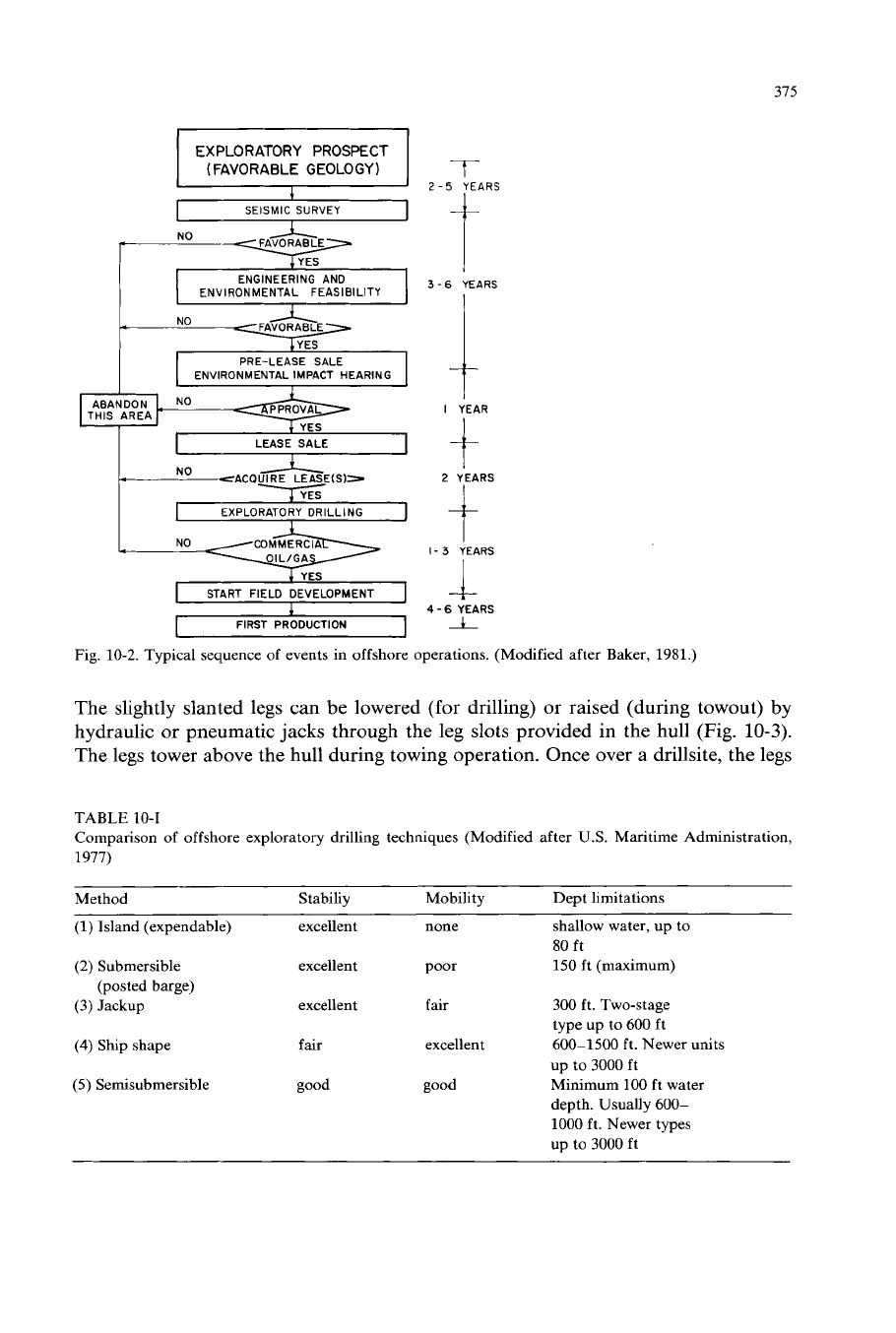
375
(FAVORABLE
GEOLOGY)
1
SEISMIC
SURVEY
I
ENGINEERING AND
ENVIRONMENTAL FEASIBILITY
c
NO
A
I
JYES
PRE-LEASE SALE
I
ENVIRONMENTAL IMPACT HEARING
I
I
I
I
I
I
ABANDON
NO
THIS AREA
I
L
I
1
1
START FIELD DEVELOPMENT
i
I
FIRST PRODUCTION
1
2-5
YEARS
!
3-6
YEARS
I
I
I
YEAR
t-
2
YEARS
I
t
I-
3
YEARS
J-
4-6
YEARS
_L
Fig.
10-2.
Typical sequence of events in offshore operations. (Modified after Baker,
1981.)
The slightly slanted legs can be lowered
(for
drilling)
or
raised (during towout) by
hydraulic
or
pneumatic jacks through the leg slots provided in the hull (Fig.
10-3).
The legs tower above the hull during towing operation. Once over a drillsite, the legs
TABLE
10-1
Comparison
of
offshore exploratory drilling techniques (Modified after
US.
Maritime Administration,
1977)
Method Stabiliy
(1)
Island (expendable) excellent
(2)
Submersible
(3)
Jackup
(posted barge)
excellent
excellent
(4)
Ship shape
fair
(5)
Semisubmersible good
Mobility Dept limitations
none shallow water, up to
poor 150 ft (maximum)
80
ft
fair 300 ft. Two-stage
type up
to
600
ft
excellent 600-1500 ft. Newer units
up
to
3000 ft
good
Minimum
100
ft water
depth. Usually 600-
1000 ft. Newer types
up to 3000 ft
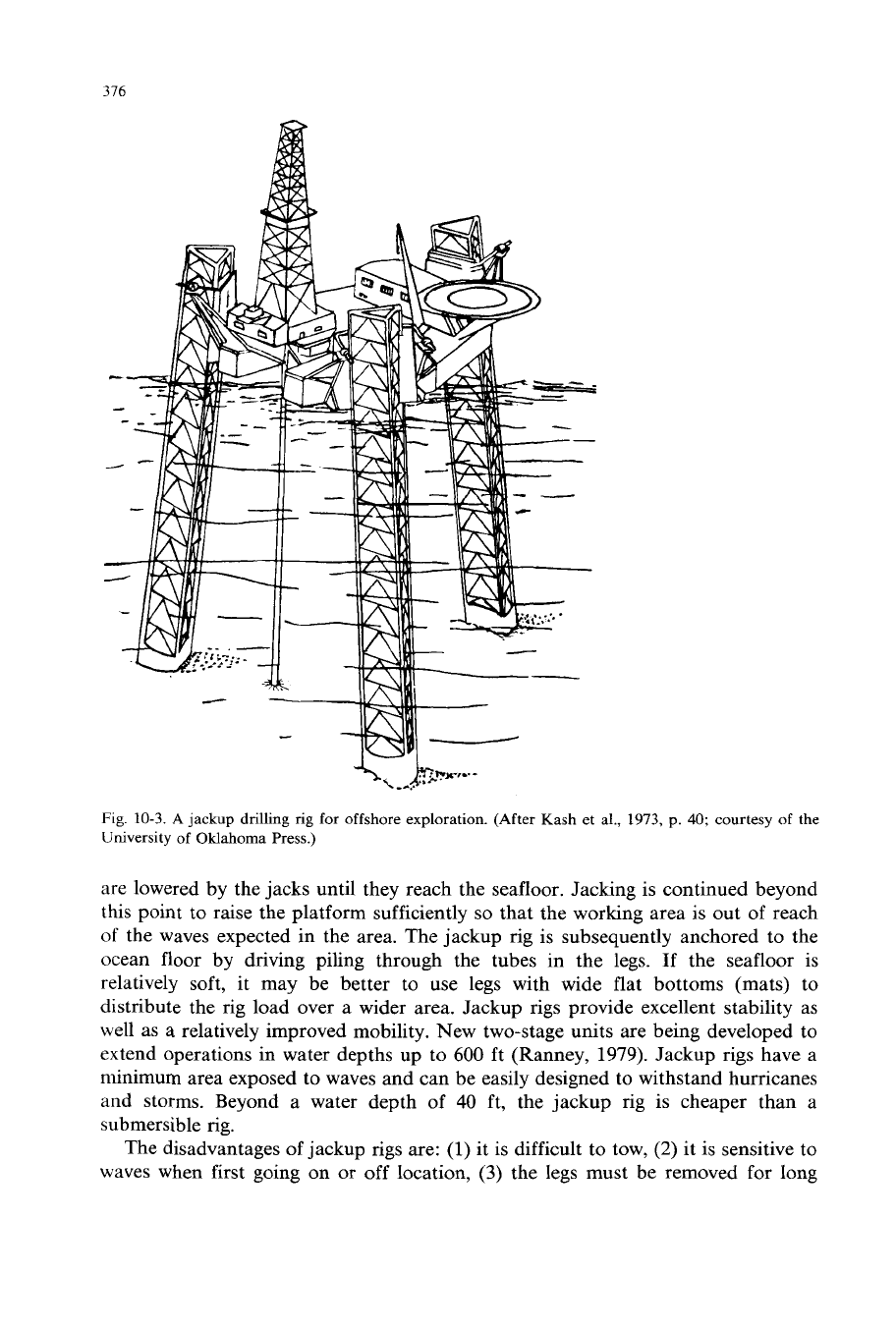
376
Fig.
10-3.
A jackup drilling
rig
for offshore exploration. (After Kash et
al.,
1973,
p.
40;
courtesy of the
University
of
Oklahoma
Press.)
are lowered by the jacks until they reach the seafloor. Jacking is continued beyond
this point to raise the platform sufficiently
so
that the working area is out of reach
of the waves expected in the area. The jackup rig is subsequently anchored to the
ocean floor by driving piling through the tubes in the legs. If the seafloor is
relatively soft, it may be better to use legs with wide flat bottoms (mats) to
distribute the rig load over a wider area. Jackup rigs provide excellent stability as
well as
a
relatively improved mobility. New two-stage units are being developed to
extend operations in water depths up to
600
ft (Ranney,
1979).
Jackup rigs have a
minimum area exposed to waves and can be easily designed to withstand hurricanes
and storms. Beyond a water depth of
40
ft, the jackup rig is cheaper than a
submersible rig.
The disadvantages of jackup rigs are:
(1)
it is difficult to tow,
(2)
it is sensitive
to
waves when first going on or
off
location,
(3)
the legs must be removed for long
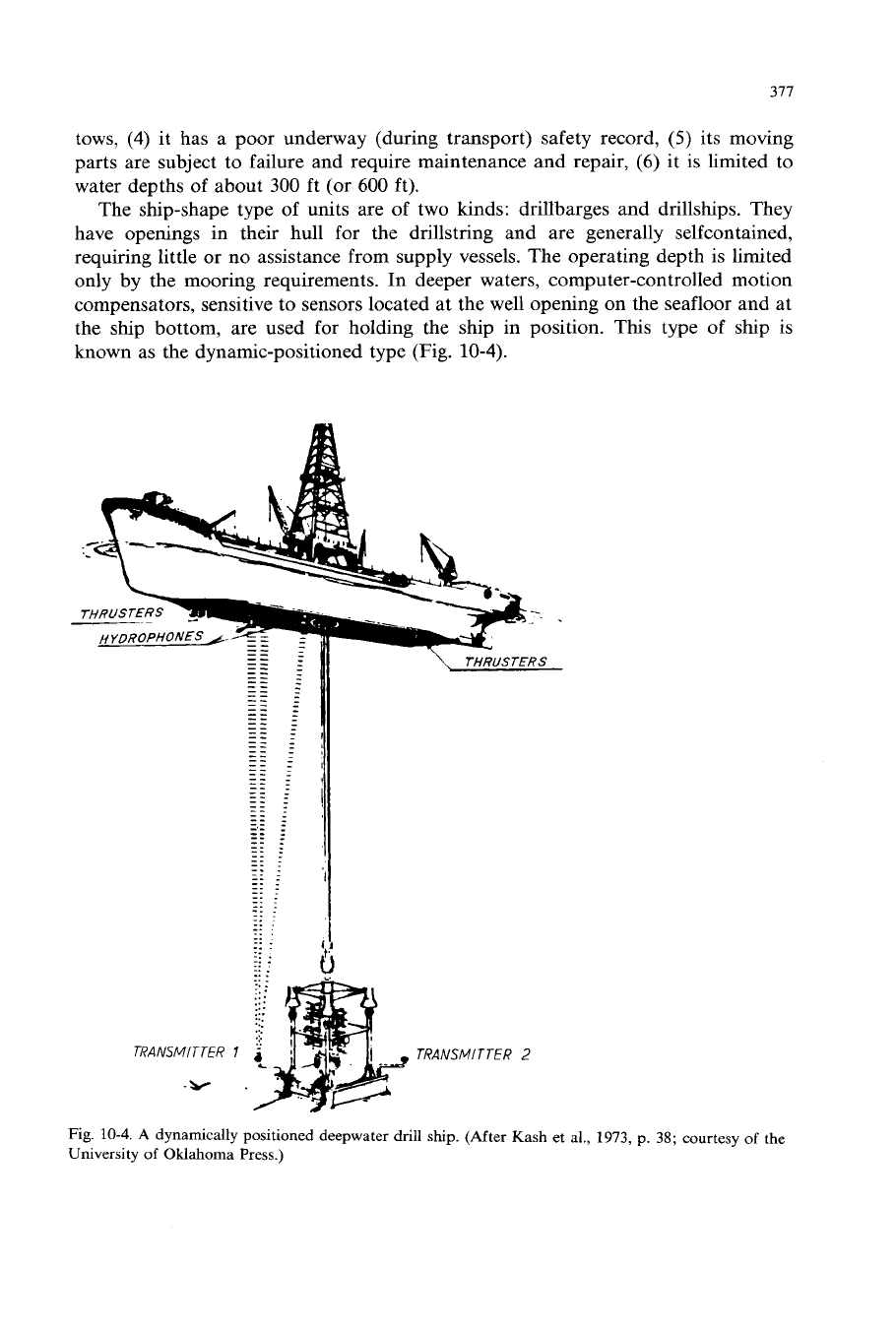
377
tows,
(4)
it has a poor underway (during transport) safety record, (5) its moving
parts are subject to failure and require maintenance and repair,
(6)
it is limited to
water depths of about
300
ft (or
600
ft).
The slup-shape type
of
units are of two lunds: drillbarges and drillships. They
have openings in their hull for the drillstring and are generally selfcontained,
requiring little or no assistance from supply vessels. The operating depth is limited
only by the mooring requirements. In deeper waters, computer-controlled motion
compensators, sensitive to sensors located at the well opening on the seafloor and at
the ship bottom, are used for holding the ship in position. This type
of
sh~p is
known as the dynamic-positioned type (Fig. 10-4).
TRANSMITTER
2
Fig.
10-4.
A dynamically positioned deepwater drill ship. (After Kash et al., 1973, p.
38;
courtesy
of
the
University
of
Oklahoma Press.)
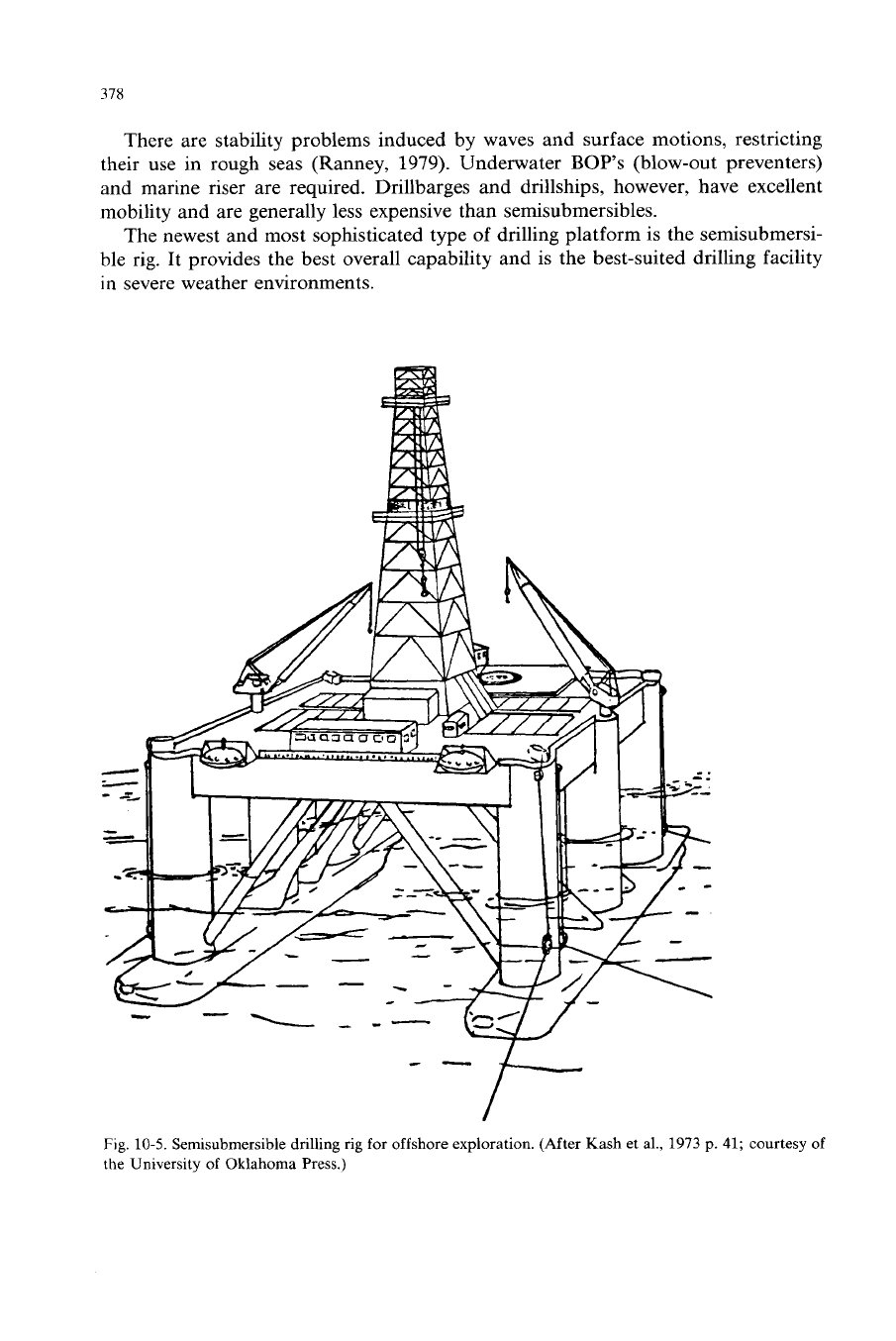
378
There are stability problems induced by waves and surface motions, restricting
their use in rough seas (Ranney,
1979).
Underwater
BOP'S
(blow-out preventers)
and marine riser are required. Drillbarges and drillships, however, have excellent
mobility and are generally less expensive than semisubmersibles.
The newest and most sophisticated type
of
drilling platform is the semisubmersi-
ble rig. It provides the best overall capability and is the best-suited drilling facility
in
severe weather environments.
-
7-
Fig.
10-5.
Semisubmersible drilling rig for offshore exploration. (After Kash et al.,
1973
p. 41; courtesy
of
the University of Oklahoma Press.)
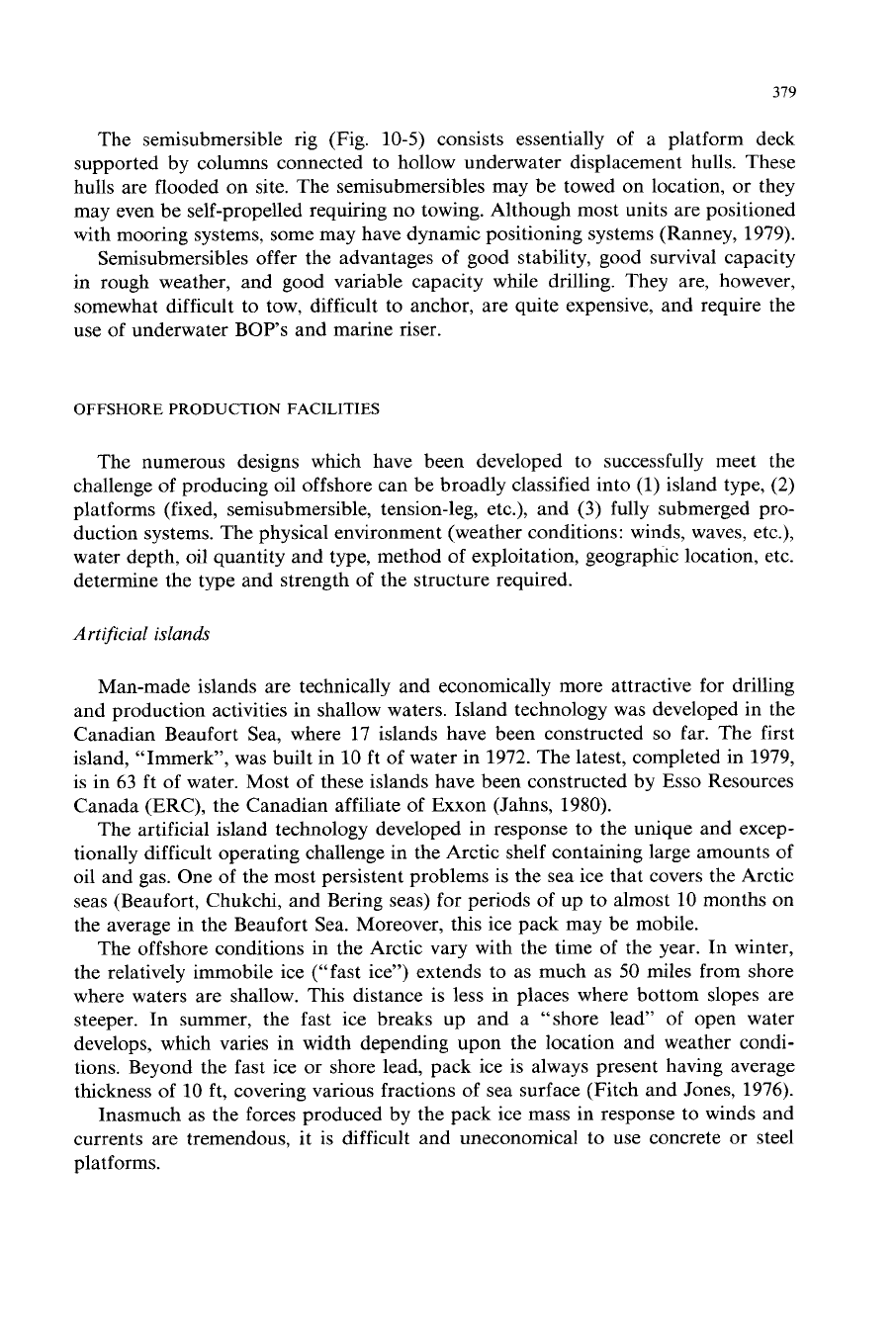
379
The semisubmersible rig (Fig. 10-5) consists essentially of a platform deck
supported by columns connected to hollow underwater displacement hulls. These
hulls are flooded on site. The semisubmersibles may be towed on location, or they
may even be self-propelled requiring no towing. Although most units are positioned
with mooring systems, some may have dynamic positioning systems (Ranney, 1979).
Semisubmersibles offer the advantages of good stability, good survival capacity
in rough weather, and good variable capacity while drilling. They are, however,
somewhat difficult to tow, difficult to anchor, are quite expensive, and require the
use of underwater BOP’S and marine riser.
OFFSHORE PRODUCTION FACILITIES
The numerous designs which have been developed to successfully meet the
challenge of producing oil offshore can be broadly classified into (1) island type, (2)
platforms (fixed, semisubmersible, tension-leg, etc.), and (3) fully submerged pro-
duction systems. The physical environment (weather conditions: winds, waves, etc.),
water depth, oil quantity and type, method of exploitation, geographic location, etc.
determine the type and strength of the structure required.
Artificial
islands
Man-made islands are technically and economically more attractive for drilling
and production activities in shallow waters. Island technology was developed in the
Canadian Beaufort Sea, where
17
islands have been constructed
so
far. The first
island, “Immerk”, was built in 10 ft of water in 1972. The latest, completed in 1979,
is in 63 ft of water. Most
of
these islands have been constructed by Esso Resources
Canada (ERC), the Canadian affiliate of Exxon (Jahns, 1980).
The artificial island technology developed in response to the unique and excep-
tionally difficult operating challenge in the Arctic shelf containing large amounts of
oil and gas. One of the most persistent problems is the sea ice that covers the Arctic
seas (Beaufort, Chukchi, and Bering seas) for periods of up to almost
10
months on
the average in the Beaufort Sea. Moreover, this ice pack may be mobile.
The offshore conditions in the Arctic vary with the time
of
the year. In winter,
the relatively immobile ice (“fast ice”) extends to as much as
50
miles from shore
where waters are shallow. This distance is less in places where bottom slopes are
steeper. In summer, the fast ice breaks up and a “shore lead” of open water
develops, which varies in width depending upon the location and weather condi-
tions. Beyond the fast ice or shore lead, pack ice is always present having average
thickness of
10
ft, covering various fractions of sea surface (Fitch and Jones, 1976).
Inasmuch as the forces produced by the pack ice mass in response to winds and
currents are tremendous, it is difficult and uneconomical to use concrete or steel
platforms.
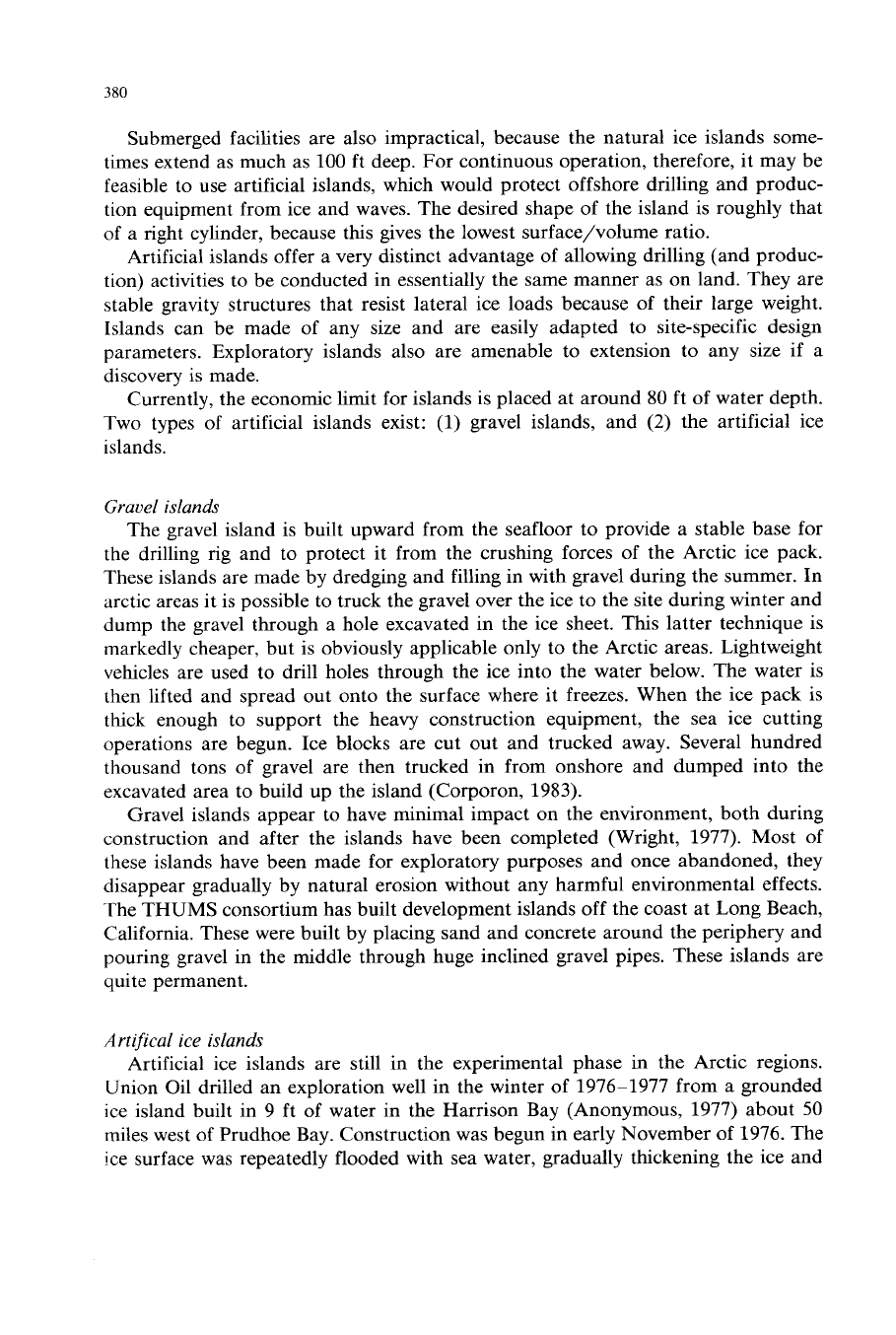
3
80
Submerged facilities are also impractical, because the natural ice islands some-
times extend as much as
100
ft deep. For continuous operation, therefore, it may be
feasible to use artificial islands, which would protect offshore drilling and produc-
tion equipment from ice and waves. The desired shape of the island is roughly that
of a right cylinder, because ths gives the lowest surface/volume ratio.
Artificial islands offer a very distinct advantage of allowing drilling (and produc-
tion) activities to be conducted in essentially the same manner as on land. They are
stable gravity structures that resist lateral ice loads because of their large weight.
Islands can be made of any size and are easily adapted to site-specific design
parameters. Exploratory islands also are amenable to extension to any size if a
discovery is made.
Currently, the economic limit for islands is placed at around
80
ft of water depth.
Two types of artificial islands exist:
(1)
gravel islands, and
(2)
the artificial ice
islands.
Gravel islands
The gravel island is built upward from the seafloor to provide a stable base for
the drilling rig and to protect it from the crushing forces
of
the Arctic ice pack.
These islands are made by dredging and filling in with gravel during the summer. In
arctic areas it is possible to truck the gravel over the ice to the site during winter and
dump the gravel through a hole excavated in the ice sheet. This latter technique is
markedly cheaper, but is obviously applicable only to the Arctic areas. Lightweight
vehicles are used to drill holes through the ice into the water below. The water is
then lifted and spread out onto the surface where it freezes. When the ice pack is
thick enough to support the heavy construction equipment, the sea ice cutting
operations are begun. Ice blocks are cut out and trucked away. Several hundred
thousand tons of gravel are then trucked in from onshore and dumped into the
excavated area to build up the island (Corporon, 1983).
Gravel islands appear to have minimal impact on the environment, both during
construction and after the islands have been completed (Wright, 1977). Most of
these islands have been made for exploratory purposes and once abandoned, they
disappear gradually by natural erosion without any harmful environmental effects.
The THUMS consortium has built development islands
off
the coast at Long Beach,
California. These were built by placing sand and concrete around the periphery and
pouring gravel in the middle through huge inclined gravel pipes. These islands are
quite permanent.
Artifical
ice
islands
Artificial ice islands are still in the experimental phase in the Arctic regions.
Union Oil drilled an exploration well in the winter of 1976-1977 from a grounded
ice island built in 9 ft of water in the Harrison Bay (Anonymous, 1977) about
50
miles west of Prudhoe Bay. Construction was begun in early November
of
1976. The
ice surface was repeatedly flooded with sea water, gradually thckening the ice and
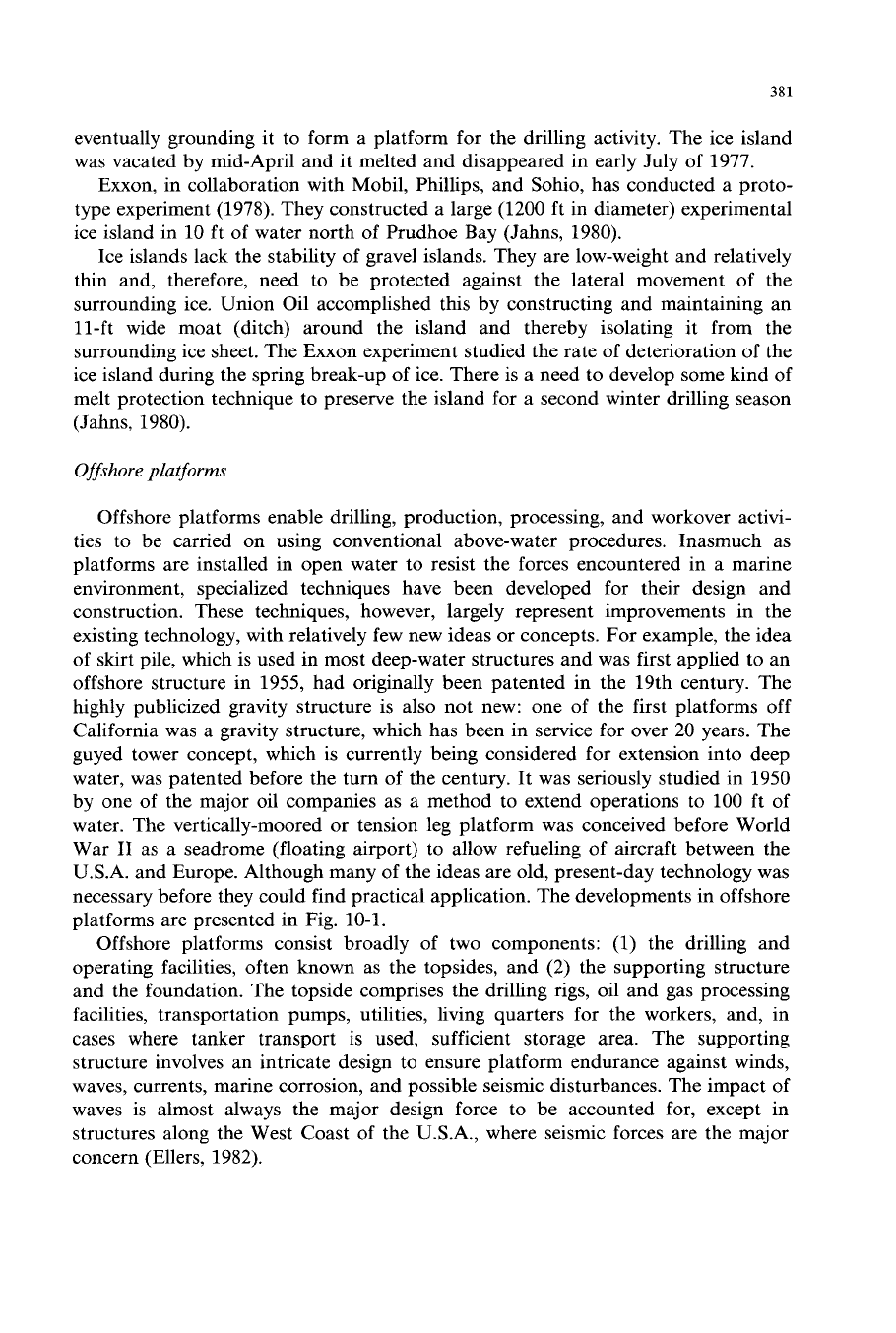
381
eventually grounding it to form a platform for the drilling activity. The ice island
was vacated by mid-April and it melted and disappeared in early July of 1977.
Exxon, in collaboration with Mobil, Phillips, and Sohio, has conducted a proto-
type experiment (1978). They constructed a large (1200 ft in diameter) experimental
ice island in 10 ft of water north of Prudhoe Bay (Jahns, 1980).
Ice islands lack the stability of gravel islands. They are low-weight and relatively
thin and, therefore, need to be protected against the lateral movement of the
surrounding ice. Union Oil accomplished this by constructing and maintaining an
11-ft wide moat (ditch) around the island and thereby isolating it from the
surrounding ice sheet. The Exxon experiment studied the rate of deterioration of the
ice island during the spring break-up
of
ice. There is a need to develop some kind of
melt protection technique to preserve the island for a second winter drilling season
(Jahns, 1980).
Offshore
platforms
Offshore platforms enable drilling, production, processing, and workover activi-
ties to be carried on using conventional above-water procedures. Inasmuch as
platforms are installed in open water to resist the forces encountered in a marine
environment, specialized techniques have been developed for their design and
construction. These techniques, however, largely represent improvements in the
existing technology, with relatively few new ideas or concepts. For example, the idea
of skirt pile, which is used in most deep-water structures and was first applied to an
offshore structure in 1955, had originally been patented in the 19th century. The
highly publicized gravity structure is also not new: one of the first platforms off
California was a gravity structure, which has been in service for over 20 years. The
guyed tower concept, which is currently being considered for extension into deep
water, was patented before the turn of the century. It was seriously studied in 1950
by one of the major oil companies as a method to extend operations to
100
ft of
water. The vertically-moored or tension leg platform was conceived before World
War I1 as a seadrome (floating airport) to allow refueling of aircraft between the
U.S.A. and Europe. Although many of the ideas are old, present-day technology was
necessary before they could find practical application. The developments in offshore
platforms are presented in Fig. 10-1.
Offshore platforms consist broadly of two components:
(1)
the drilling and
operating facilities, often known as the topsides, and (2) the supporting structure
and the foundation. The topside comprises the drilling rigs, oil and gas processing
facilities, transportation pumps, utilities, living quarters for the workers, and, in
cases where tanker transport is used, sufficient storage area. The supporting
structure involves an intricate design to ensure platform endurance against winds,
waves, currents, marine corrosion, and possible seismic disturbances. The impact of
waves is almost always the major design force to be accounted for, except in
structures along the West Coast of the U.S.A., where seismic forces are the major
concern (Ellers, 1982).
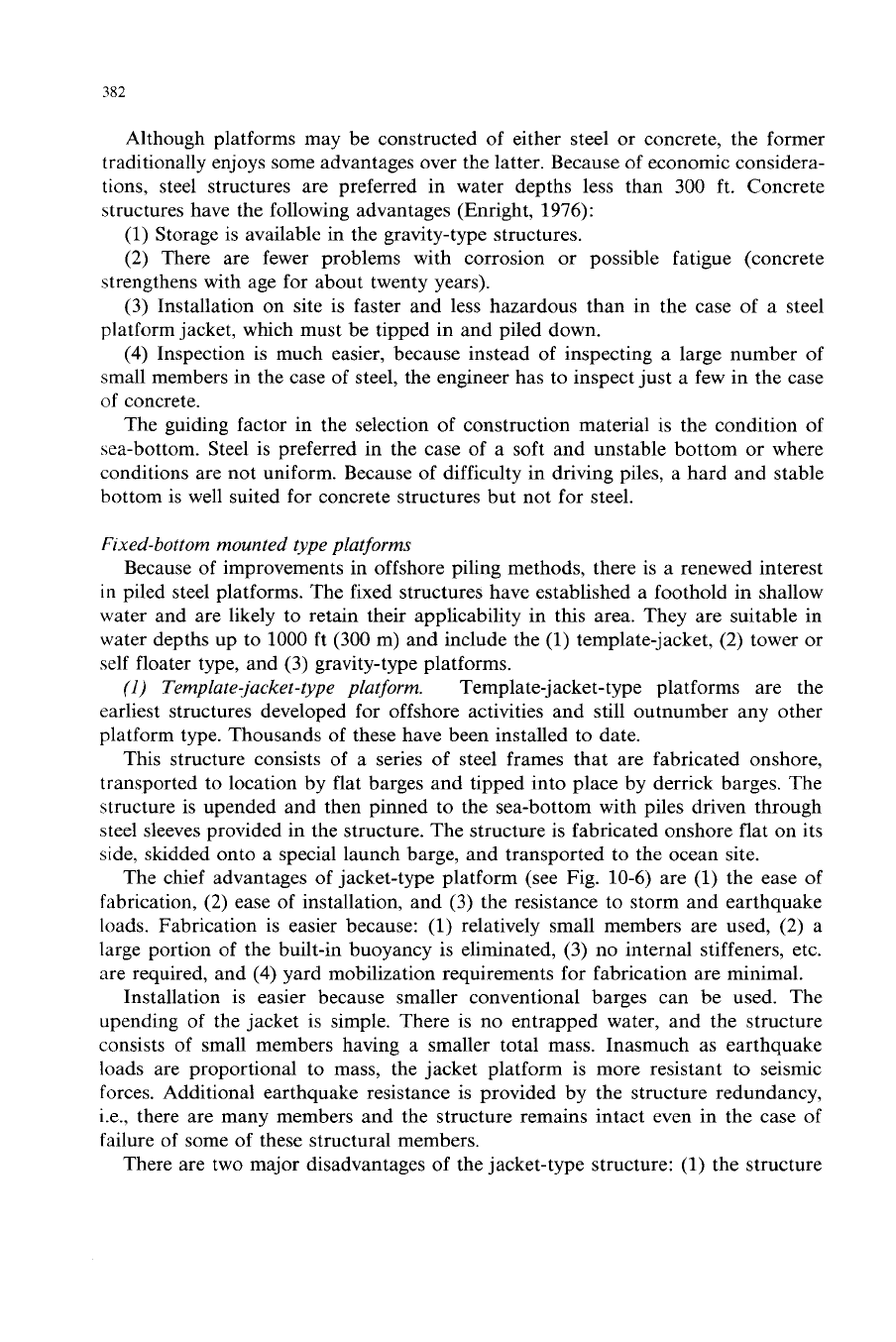
382
Although platforms may be constructed
of
either steel or concrete, the former
traditionally enjoys some advantages over the latter. Because
of
economic considera-
tions, steel structures are preferred in water depths less than
300
ft. Concrete
structures have the following advantages (Enright, 1976):
(1) Storage is available in the gravity-type structures.
(2)
There are fewer problems with corrosion or possible fatigue (concrete
strengthens with age for about twenty years).
(3)
Installation on site is faster and less hazardous than in the case
of
a steel
platform jacket, which must be tipped in and piled down.
(4)
Inspection is much easier, because instead of inspecting a large number of
small members in the case of steel, the engineer has to inspect just a few in the case
of
concrete.
The guiding factor in the selection
of
construction material is the condition of
sea-bottom. Steel is preferred in the case
of
a soft and unstable bottom or where
conditions are not uniform. Because of difficulty in driving piles, a hard and stable
bottom is well suited for concrete structures but not for steel.
Fixed-bottom mounted type platforms
Because
of
improvements in offshore piling methods, there
is
a renewed interest
in
piled steel platforms. The fixed structures have established a foothold in shallow
water and are likely to retain their applicability in this area. They are suitable in
water depths up to
1000
ft
(300
m) and include the (1) template-jacket,
(2)
tower or
self floater type, and
(3)
gravity-type platforms.
(I)
Templute-jucket-type platform.
Template-jacket-type platforms are the
earliest structures developed for offshore activities and still outnumber any other
platform type. Thousands of these have been installed to date.
This structure consists of a series of steel frames that are fabricated onshore,
transported to location by flat barges and tipped into place by derrick barges. The
structure is upended and then pinned to the sea-bottom with piles driven through
steel sleeves provided in the structure. The structure is fabricated onshore flat on its
side, skidded onto a special launch barge, and transported to the ocean site.
The chief advantages
of
jacket-type platform (see Fig. 10-6) are
(1)
the ease of
fabrication,
(2)
ease of installation, and
(3)
the resistance to storm and earthquake
loads. Fabrication is easier because:
(1)
relatively small members are used,
(2)
a
large portion of the built-in buoyancy is eliminated,
(3)
no internal stiffeners, etc.
are required, and
(4)
yard mobilization requirements for fabrication are minimal.
Installation is easier because smaller conventional barges can be used. The
upending of the jacket is simple. There is
no
entrapped water, and the structure
consists of small members having a smaller total mass. Inasmuch as earthquake
loads are proportional to mass, the jacket platform is more resistant to seismic
forces. Additional earthquake resistance is provided by the structure redundancy,
i.e.,
there are many members and the structure remains intact even in the case of
failure of some of these structural members.
There are two major disadvantages
of
the jacket-type structure: (1) the structure

383
i
.-
Fig.
10-6.
A
fixed-leg jacket platform. (Courtesy of McDermott, Inc.)
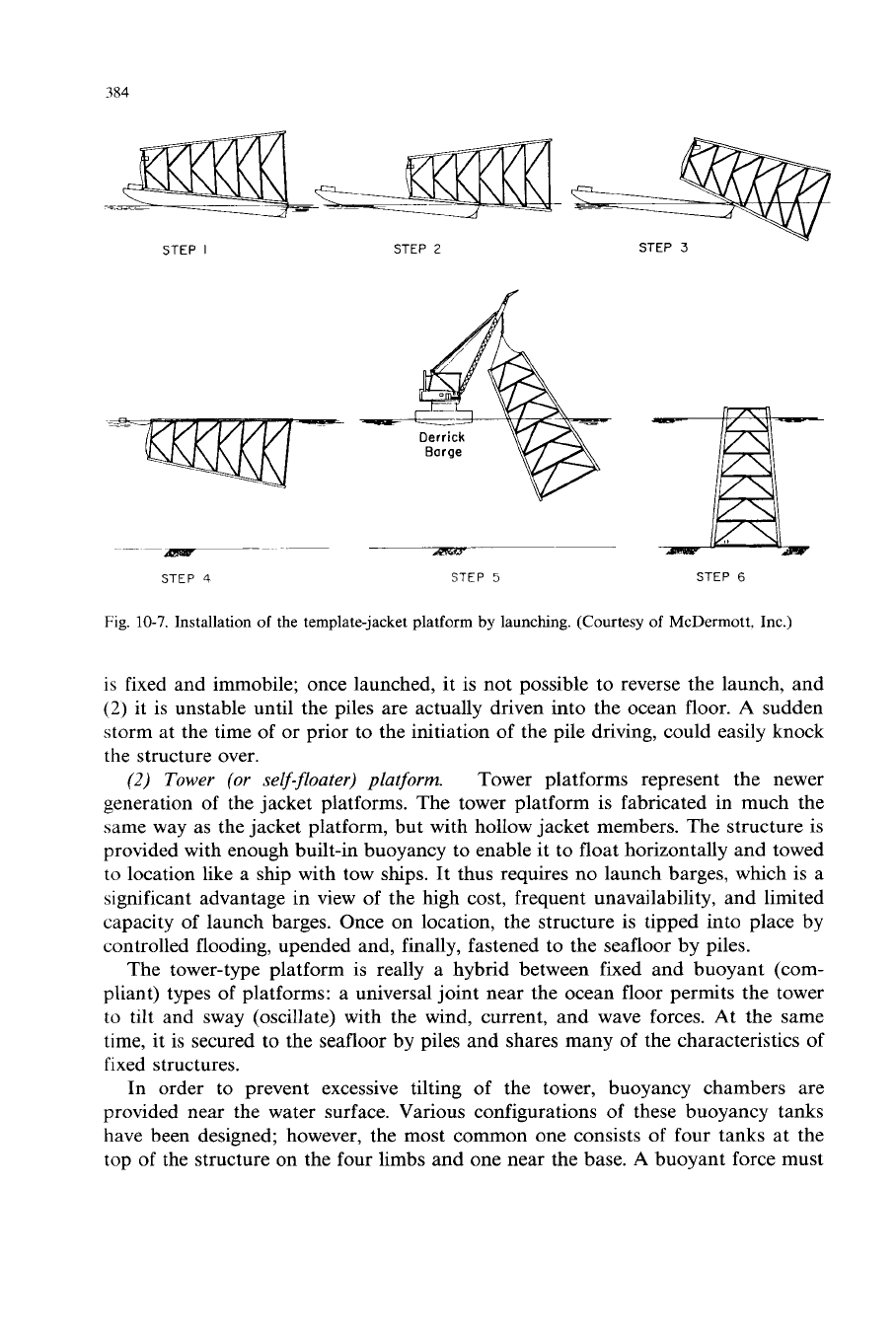
384
-
-
STEP
I
STEP
2
STEP
3
f
STEP
4
STEP
5
STEP
6
Fig.
10-7.
Installation
of
the template-jacket platform
by
launching. (Courtesy
of
McDermott, Inc.)
is
fixed and immobile; once launched, it is not possible to reverse the launch, and
(2)
it is unstable until the piles are actually driven into the ocean floor.
A
sudden
storm at the time of or prior to the initiation of the pile driving, could easily knock
the structure over.
(2)
Tower (or self-floater) platform.
Tower platforms represent the newer
generation
of
the jacket platforms. The tower platform is fabricated in much the
same way as the jacket platform, but with hollow jacket members. The structure is
provided with enough built-in buoyancy to enable it to float horizontally and towed
to location like a ship with tow ships. It thus requires no launch barges, which is a
significant advantage in view of the high cost, frequent unavailability, and limited
capacity
of
launch barges. Once
on
location, the structure is tipped into place by
controlled flooding, upended and, finally, fastened to the seafloor by piles.
The tower-type platform
is
really a hybrid between fixed and buoyant (com-
pliant) types
of
platforms: a universal joint near the ocean floor permits the tower
to tilt and sway (oscillate) with the wind, current, and wave forces. At the same
time, it is secured to the seafloor by piles and shares many of the characteristics of
fixed structures.
In order to prevent excessive tilting of the tower, buoyancy chambers are
provided near the water surface. Various configurations
of
these buoyancy tanks
have been designed; however, the most common one consists of four tanks at the
top of the structure on the four limbs and one near the base.
A
buoyant force must
